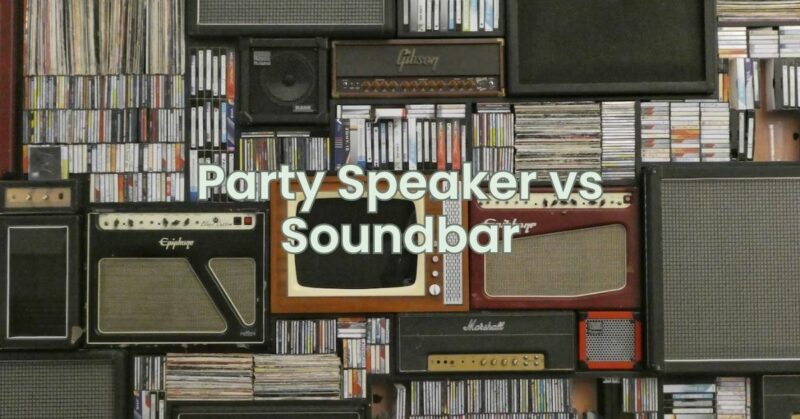When it comes to enhancing your audio experience for parties or entertainment purposes, two popular options are party speakers and soundbars. While both aim to provide improved sound quality, they serve different functions and cater to distinct settings. In this article, we will compare party speakers and soundbars to help you understand their differences and determine which audio solution is better suited for your needs.
Party Speakers: Party speakers are designed to deliver powerful and dynamic audio for social gatherings, parties, or events. They are built to provide high volume levels, energetic sound, and additional features for an engaging party experience. Here are key points to understand about party speakers:
- Portability and Power: Party speakers are designed to be portable, allowing you to take the party anywhere. They often feature built-in handles or wheels for easy transportation. These speakers prioritize powerful sound output and high volume levels to energize the crowd and fill larger spaces.
- Connectivity and Compatibility: Party speakers offer various connectivity options, such as Bluetooth, USB ports, auxiliary inputs, or even built-in media players. They allow for seamless wireless streaming from smartphones, tablets, or other compatible devices. Additionally, some party speakers may include microphone inputs, karaoke functionality, or DJ effects to enhance the party experience.
- Sound Dispersion and Bass Response: Party speakers are engineered to provide wide sound dispersion, ensuring that the audio reaches a large crowd. They prioritize bass response, often incorporating larger woofers or dedicated subwoofers to deliver thumping low frequencies that energize the atmosphere.
- Lighting and Effects: Many party speakers feature built-in LED lights or other lighting effects that sync with the music, creating a vibrant visual display. These lighting features add to the party ambiance and contribute to a more immersive experience.
Soundbars: Soundbars are designed to enhance the audio experience for televisions, providing improved sound quality and clarity compared to built-in TV speakers. They are compact and sleek, making them a popular choice for home entertainment setups. Here are key points to understand about soundbars:
- Space Efficiency and Design: Soundbars are compact and typically designed to sit underneath or in front of a TV. They offer a space-saving solution compared to traditional speaker setups. Soundbars are visually appealing, complementing the aesthetics of a home entertainment system.
- Audio Enhancement for TVs: Soundbars focus on improving TV audio by providing clearer dialogue, enhanced soundstage, and better overall sound quality. They often include multiple built-in speakers and drivers, including dedicated tweeters and midrange drivers, to reproduce a wider range of frequencies.
- Virtual Surround Sound: Many soundbars utilize virtual surround sound technology to create a simulated surround sound experience. Through digital signal processing and audio algorithms, they aim to replicate the immersive soundstage of a multi-speaker setup without the need for additional speakers or wiring.
- Connectivity and Integration: Soundbars offer various connectivity options, including HDMI ARC, optical audio, or Bluetooth, allowing seamless integration with TVs and other audio sources. They are designed to work with different audio formats and can often be controlled via remote or smartphone apps.
Different Functions, Specific Settings: Party speakers and soundbars serve different functions and cater to specific settings. Here’s how they differ:
- Portable Party vs. Home Entertainment: Party speakers are designed for portable audio solutions, energizing social gatherings and parties in larger spaces. Soundbars are tailored for home entertainment setups, focusing on enhancing TV audio quality and creating an immersive experience within a confined space.
- Crowd Engagement vs. Personal Enjoyment: Party speakers aim to engage a crowd, offering high volume levels, bass-heavy sound, and additional features like lighting effects and microphone inputs. Soundbars focus on personal enjoyment, delivering improved audio quality, clarity, and dialogue intelligibility for individual or small group viewing.
- Versatility vs. Specialized Audio: Party speakers provide versatility with a range of connectivity options, compatibility with various devices, and additional features like karaoke or DJ effects. Soundbars specialize in TV audio enhancement, focusing on optimizing dialogue, soundstage, and overall sound quality for movies, TV shows, and gaming.
- Portability vs. Aesthetics: Party speakers prioritize portability, featuring handles or wheels for easy transport. Soundbars emphasize aesthetics and space efficiency, seamlessly integrating with TV setups and blending in with the overall home decor.
Conclusion: Party speakers and soundbars serve different purposes and excel in distinct settings. Party speakers are designed for portable audio solutions, energizing parties and social gatherings with powerful sound, crowd engagement features, and portability. Soundbars specialize in enhancing TV audio quality and creating an immersive experience within a home entertainment setup. Understanding the distinctions between party speakers and soundbars will help you choose the audio solution that best suits your needs, whether it’s creating a lively party atmosphere or elevating the audio experience of your home entertainment system.


